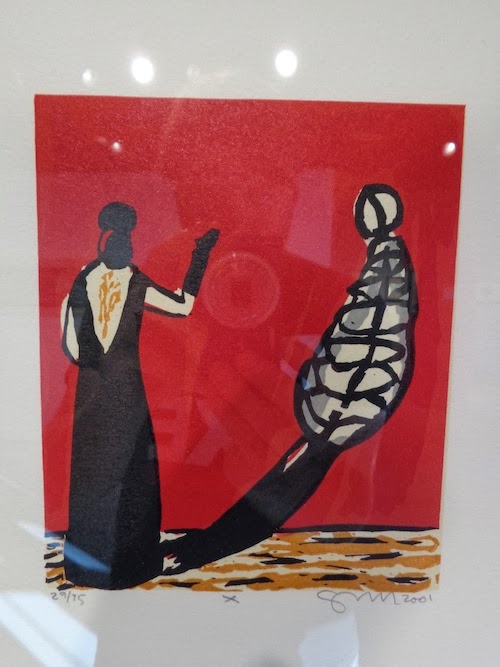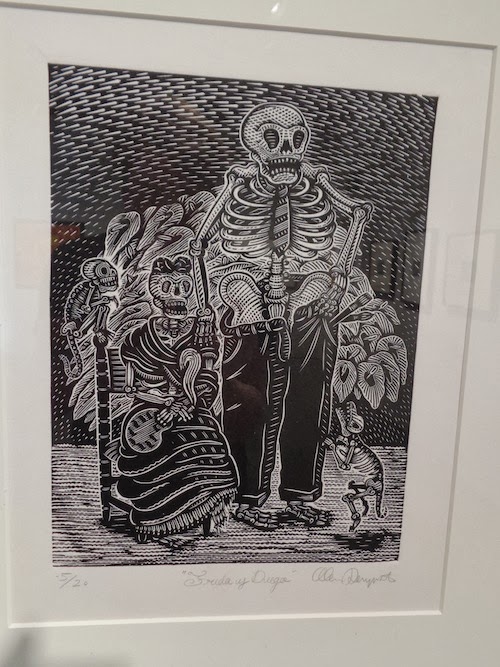Today, I visited the current exhibit at the Fullerton College Art Gallery, La Xilografia: Mexican Woodcut Prints. It's a lovely show, so I decided to take some pictures and notes, and share what I saw and learned...
This collaborative exhibition between the Muckenthaler Cultural Center and Fullerton College Art Gallery explores the tradition of woodblock prints by contemporary and past Mexican and Mexican American artists. La Xilografía features works by Raúl Anguiano, Abel Alejandre, Judith Duran, Marianne Sadowski, Gronk Nicandro, Alec Dempster, Artemio Rodriguez and more. Their work uses many of the same traditional techniques developed by their predecessors in centuries past, but is informed by contemporary aesthetics sensibilities and social conditions.
Artemio Rodriguez was born in Tacámbaro, Michoacan, Mexico. Artemio is a self-taught artist. At the age of seventeen, he learned the fundamentals of linocut, while working as a printer's apprentice in the workshop of John Pascoe Kingfisher. At the age of twenty-one he emigrated to Los Angeles, California, where, after work painting houses, began selling his work and eventually managed to devote full time to artistic creation. He currently divides his time between Los Angeles and his workshop in a rural community near his hometown, Tacámbaro.
Marianne Sadowski was born and raised in Mexico City to a Mexican mother and German father. While growing up, she was immersed in the fine art community. Her husband was offered a job in Los Angeles, an opportunity that opened her eyes to the unique immigrant experience -- one that meant adjusting to a capitalistic society while still maintaining valuable Mexican traditions. For the first time, Sadowski began to witness the perspective of Mexico as an American. Her new insights have given her a sense of disillusionment, yet they have also helped her to appreciate the struggles of her fellow immigrants -- and these reflections are evident in her pieces.
"Drawing was an escape for me -- from poverty, from my environment. It was a way of creating new worlds for myself."
Born in 1957 in East Los Angeles, California, Glugio Nicandro is a Chicano artist and printmaker. Better known as Gronk, his works are based on themes such as pop culture, love, and ethnic identity. Self-taught, he knew by a young age that he wanted to be an artist. His artistic career started around 1972 when he co-founded ASCO, a Chicano art collective that was influenced less by the overt political stance of other Chicano artists and more by European cinema, literature, and existential philosophy. Gronk has exhibited widely throughout the world, and his work is found in many museum collections, including the Fullerton College permanent collection.
Judith Duran is an artist from Guanajuato, Mexico living in Los Angeles. She primarily works in printmaking, but she also paints and works in ceramics.
Born in Mexico City in 1971 and raised in Toronto, Canada, Alec Dempster is an artist and musician highly influenced by traditional Mexican folk music. He returned to Mexico in 1995, settled in Xalapa, Veracruz, and immersed himself in the area's distinct musical style called son jarocho. Many of his relief prints portray son jarocho musicians and the tropical environment of this Gulf Coastal region. Some of his best known works-- "El Fandaguito," "Loteria de Sones Jarochos," and "Loteria Huasteca" -- are games he developed as educational tools based on the traditional game, Loteria. He has had solo exhibitions in the United States, Canada, Mexico, France, and Spain. An accomplished son jarocho musician himself, Dempster now resides back in Toronto, carrying on the Mexican folk tradition through his music and art.
"Each piece is like an oversized blanket, that is, by turns comforting, but also suffocating. But for those willing to dig deeper, my art serves as an optimistic roadmap that depicts the intimate, honest struggle against hatred and betrayal -- a struggle that ultimately leads to salvation and redemption."
Abel Alejandre immigrated to Los Angeles in 1975 from Apatsingan, Michoacan, Mexico. He draws his inspiration from three distinct masters: Caravaggio, Raphael, and Goya. Alejandre describes his artistic style as "Mannerism with a twist." His aesthetic can be viewed through his choice of medium, and by the vivid cathartic subject matter of his works. Like his mentor, Caravaggio, Alejandre emphasizes the autobiographical and demonstrates his prominent values, beliefs, and philosophies. He is currently working on large-scale drawings which will be translated onto tile for a Los Angeles Metro Station.
This year not only marks the centenary of Fullerton College, but also the centenary of Jose Guadalupe Posadas death. So it is with great pleasure that Posada, one of the most iconic figures in modern Mexican art, is also included in this special exhibition.
Born in 1852 in the central city of Aguascalientes, Posada is regarded as the father of graphic arts in Mexico. He is best known for his satirical images of politicians, clerics, revolutionaries, and other members of Mexican society. In recent decades, his name has become synonymous with The Day of the Dead and its celebrations. It seems difficult to realize that this Mexican master was all but forgotten until the 1920s, when the French artist Jean Charlot rediscovered his genius and introduced him to the world.
This exhibit runs through November 18 and is FREE and open to the public. The Fullerton College Art Gallery is open Monday-Thursday from 10am-12pm and 2pm-4pm. The gallery is located at 321 E. Chapman Ave. in lovely Fullerton, CA. You can find them on Facebook HERE.











































